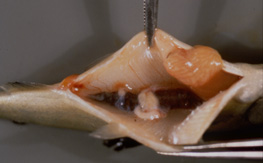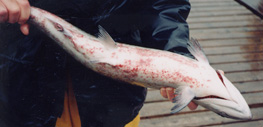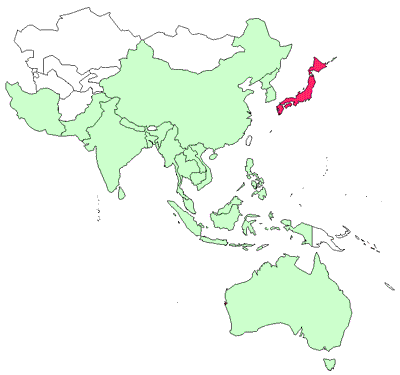Diseases of finfish
Bacterial diseases—Bacterial kidney disease
CLICK ON IMAGE TO ENLARGE

Source: R Pascho/C O'Farrell
CLICK ON IMAGE TO ENLARGE

Source: R Pascho/D Elliott
Signs of disease
Important: animals with disease may show one or more of the signs below, but disease may still be present in the absence of any signs.
Disease signs at the tank and pond level
- increasing mortality
Clinical signs of disease in an infected animal
- some fish show exophthalmus (pop eye), distended stomachs and skin lesions
Gross signs of disease in an infected animal
- creamy white granulomas in kidney and sometimes in liver and spleen
- fluid in stomach cavity
- haemorrhages on abdominal wall and in the viscera
- diffuse white membranous layer on one or more internal organs
- enlarged spleen
- holes in muscle blocks
Disease agent
Bacterial kidney disease is caused by the bacterium Renibacterium salmoninarum. It is recognised as a slowly progressive and frequently fatal infection of cultured and wild salmonids in both fresh and marine waters.
Host range
Fish known to be susceptible to bacterial kidney disease:
Atlantic salmon* (Salmo salar)
bartail flathead* (Platycephalus indicus)
brook trout* (Salvelinus fontinalis)
brown trout* (Salmo trutta)
chinook salmon* (Oncorhynchus tshawytscha)
rainbow trout* (Oncorhynchus mykiss)
All fish of the salmonid family are susceptible to bacterial kidney disease, with coho salmon (Oncorhynchus kisutch) the most important worldwide source of infection.
Susceptible nonsalmonids include:
fathead minnow (Pimephales promelas)
greenling (Hexagrammos otakii)
Japanese scallop (Patinopecten yessoensis)
Pacific herring (Clupea pallasii)
sablefish (Anoplopoma fimbria)
shiner perch (Cymatogaster aggregata)
* naturally susceptible (other species have been shown to be experimentally susceptible)
Presence in Asia–Pacific

BKD has been officially reported from Japan.
Epidemiology
- The causative bacterium is likely to live only within salmonids and not in the environment.
- Other nonsalmonid species have shown infection but only when raised with highly infected salmonids.
- The bacterium is transmitted both horizontally (fish to fish via the water) and vertically (fish to egg through the generations).
- Advanced infection becomes apparent only after the first year of the fish's life.
Differential diagnosis
The differential diagnostic table and the list of similar diseases appearing at the bottom of each disease page refer only to the diseases covered by this field guide. Gross signs observed might well be representative of a wider range of diseases not included here. Therefore, these diagnostic aids should not be read as a guide to a definitive diagnosis, but rather as a tool to help identify the listed diseases that most closely account for the gross signs.
Sample collection
Because of uncertainty in differentiating diseases using only gross signs, and because some aquatic animal disease agents might pose a risk to humans, you should not try to collect samples unless you have been trained. Instead, you should phone your national hotline number and report your observations. If samples have to be collected, the agency taking the call will advise you on what you need to do. Local or district fisheries/veterinary authorities could advise you on sampling.
Emergency disease hotline
For your national emergency disease hotline number, see Whom to contact if you suspect a disease.
Further reading
http://www.oie.int/aac/eng/cards/en_diseasecard.htm
The currently accepted procedures for a conclusive diagnosis of BKD are summarised at http://www.oie.int/eng/normes/fmanual/A_00028.htm
These hyperlinks were correct and functioning at the time of publication.

